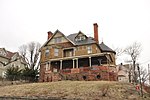Public Bath House No. 3
Buildings and structures completed in 1909Buildings and structures in Yonkers, New YorkNational Register of Historic Places in Yonkers, New YorkPublic baths in the United StatesPublic baths on the National Register of Historic Places in New York (state) ... and 2 more
Renaissance Revival architecture in New York (state)Westchester County, New York Registered Historic Place stubs

Public Bath House No. 3, also known as Yonkers Avenue Pool, is a historic public bath located on the border of the Getty Square and Nodine Hill neighborhoods in Southwest Yonkers, Westchester County, New York. It was built in 1909 and is a two-story, five bay wide red brick building with lively tile ornamentation in the Second Renaissance Revival style. It features a hipped tile parapet at the roofline that hides the flat roof. The interior is in three sections: reception area, custodian's apartment, and a pool and showers. It was remodeled in 1930 and 1958.It was added to the National Register of Historic Places in 1985.
Excerpt from the Wikipedia article Public Bath House No. 3 (License: CC BY-SA 3.0, Authors, Images).Public Bath House No. 3
Yonkers Avenue, City of Yonkers
Geographical coordinates (GPS) Address Nearby Places Show on map
Geographical coordinates (GPS)
| Latitude | Longitude |
|---|---|
| N 40.935277777778 ° | E -73.889166666667 ° |
Address
Yonkers Avenue 48
10701 City of Yonkers
New York, United States
Open on Google Maps









